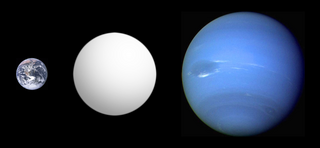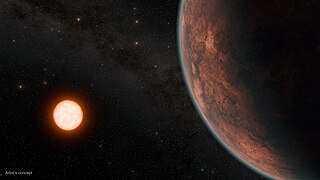Host star
GJ 3929 is a red dwarf of spectral type M3.5V [7] that is located 51.6 light years from Earth, in the constellation Corona Borealis. [3] [note 1] This star is smaller, cooler and less luminous than the Sun, having a radius of 0.32 R☉ , an effective temperature of 3,384 K (3,111 °C) and a luminosity equivalent to 1% of solar luminosity. [4] Its age is estimated between 2.2 and 11 billion years. [4]
The star also hosts another planet, called GJ 3929 c, a sub-Neptune orbits 3 times further than the innermost planet, at a distance of 0.081 astronomical units (12,100,000 km), [5] but still below the habitable zone. [8]
Gliese 581 is a red dwarf star of spectral type M3V at the center of the Gliese 581 planetary system, about 20.5 light years away from Earth in the Libra constellation. Its estimated mass is about a third of that of the Sun, and it is the 101st closest known star system to the Sun. Gliese 581 is one of the oldest, least active M dwarfs known. Its low stellar activity improves the likelihood of its planets retaining significant atmospheres, and lessens the sterilizing impact of stellar flares.

Gliese 876 d is an exoplanet 15.2 light-years away in the constellation of Aquarius. The planet was the third planet discovered orbiting the red dwarf Gliese 876, and is the innermost planet in the system. It was the lowest-mass known exoplanet apart from the pulsar planets orbiting PSR B1257+12 at the time of its discovery. Due to its low mass, it can be categorized as a super-Earth.

Gliese 436 b is a Neptune-sized exoplanet orbiting the red dwarf Gliese 436. It was the first hot Neptune discovered with certainty and was among the smallest-known transiting planets in mass and radius, until the much smaller Kepler exoplanet discoveries began circa 2010.

A Super-Earth is a type of exoplanet with a mass higher than Earth's, but substantially below those of the Solar System's ice giants, Uranus and Neptune, which are 14.5 and 17 times Earth's, respectively. The term "super-Earth" refers only to the mass of the planet, and so does not imply anything about the surface conditions or habitability. The alternative term "gas dwarfs" may be more accurate for those at the higher end of the mass scale, although "mini-Neptunes" is a more common term.
Gliese 176 is a small star with an orbiting exoplanet in the constellation of Taurus. With an apparent visual magnitude of 9.95, it is too faint to be visible to the naked eye. It is located at a distance of 30.9 light years based on parallax measurements, and is drifting further away with a heliocentric radial velocity of 26.4 km/s.

A hot Neptune is a type of giant planet with a mass similar to that of Neptune or Uranus orbiting close to its star, normally within less than 1 AU. The first hot Neptune to be discovered with certainty was Gliese 436 b (Awohali) in 2007, an exoplanet about 33 light years away. Recent observations have revealed a larger potential population of hot Neptunes in the Milky Way than was previously thought. Hot Neptunes may have formed either in situ or ex situ.

Gliese 581e or Gl 581e is an exoplanet orbiting within the Gliese 581 system, located approximately 20.4 light-years away from Earth in the Libra constellation. It is the third planet discovered in the system and the first in order from the star.
Gliese 806 is a star in the northern constellation of Cygnus, located about a degree to the southeast of the bright star Deneb. It is invisible to the naked eye with an apparent visual magnitude of +10.79. The star is located at a distance of 39.3 light years from the Sun based on stellar parallax. It is drifting closer with a radial velocity of −24.6 km/s, and is predicted to come to within 30.1 light-years in ~198,600 years. The star hosts two known planetary companions.

GJ 1214 b is an exoplanet that orbits the star GJ 1214, and was discovered in December 2009. Its parent star is 48 light-years from the Sun, in the constellation Ophiuchus. As of 2017, GJ 1214 b is the most likely known candidate for being an ocean planet. For that reason, scientists often call the planet a "waterworld".
GJ 3634 b is a super-Earth exoplanet in the orbit of the nearby red dwarf GJ 3634 at approximately 64.5 light-years in constellation Hydra. The planet is approximately eight times the mass of Earth, and orbits its star every two and a half days at a distance of 0.0287 AU. The planet was the first to be discovered by a group of astronomers searching for exoplanets in the orbit of very-low-mass stars after the team reorganized their strategy, choosing to search for targets that they could also confirm using the transit method. However, a transit event associated with GJ 3634 b was not detected. The planet's discovery was published in Astronomy and Astrophysics on February 8, 2011.
HD 97658 is a star with an exoplanetary companion in the equatorial constellation of Leo. The star is too dim to be seen with the naked eye, having an apparent visual magnitude of 7.76. It is located at a distance of 70 light years based on parallax, but is slowly drifting closer with a radial velocity of −1.6 km/s.

Gliese 357 d is an exoplanet, considered to be a "Super-Earth" within the circumstellar habitable zone of its parent star. The planet orbits Gliese 357, 31 light-years from the Solar System, The system is part of the Hydra constellation.
GJ 3470 is a red dwarf star located in the constellation of Cancer, 96 light-years away from Earth. With a faint apparent magnitude of 12.3, it is not visible to the naked eye. It hosts one known exoplanet.

Gliese 15 Ac is an exoplanet orbiting the nearby red dwarf star Gliese 15 A, which is part of a binary star system located about 11.6 light-years from the Sun. The planet was first proposed in October 2017 using radial velocity data from the CARMENES spectrograph, combined with measurements from the HARPS and HIRES spectrographs, and its existence was confirmed in April 2018 using HARPS-N data. It has a minimum mass 36 times that of Earth and orbits at around 5.4 astronomical units with a period of 7,600 days, an orbit which may have been sculpted by interaction with the companion star, Gliese 15 B. As of 2020, Gliese 15 Ac is the longest-period sub-Jovian planet discovered by radial velocity.
Kepler-737b is a super-Earth exoplanet 669 light years away. There is a chance it could be on the inner edge of the habitable zone.

Over the years, our ability to detect, confirm, and characterize exoplanets and their atmospheres has improved, allowing researchers to begin constraining exoplanet interior composition and structure. While most exoplanet science is focused on exoplanetary atmospheric environments, the mass and radius of a planet can tell us about a planet's density, and hence, its internal processes. The internal processes of a planet are partly responsible for its atmosphere, and so they are also a determining factor in a planet's capacity to support life.

GJ 3929, also known as Gliese 3929 and TOI-2013, is a red dwarf star located 51.6 light-years from Earth, in the constellation Corona Borealis. With an apparent magnitude of 12, it is not visible to the naked eye. In 2022, two exoplanets were detected orbiting the star.

Gliese 12 is a red dwarf star located 39.7 light-years away in the constellation Pisces. It has about 24% the mass and 26% the radius of the Sun, and a temperature of about 3,296 K. It is an inactive star and hosts one known exoplanet.











